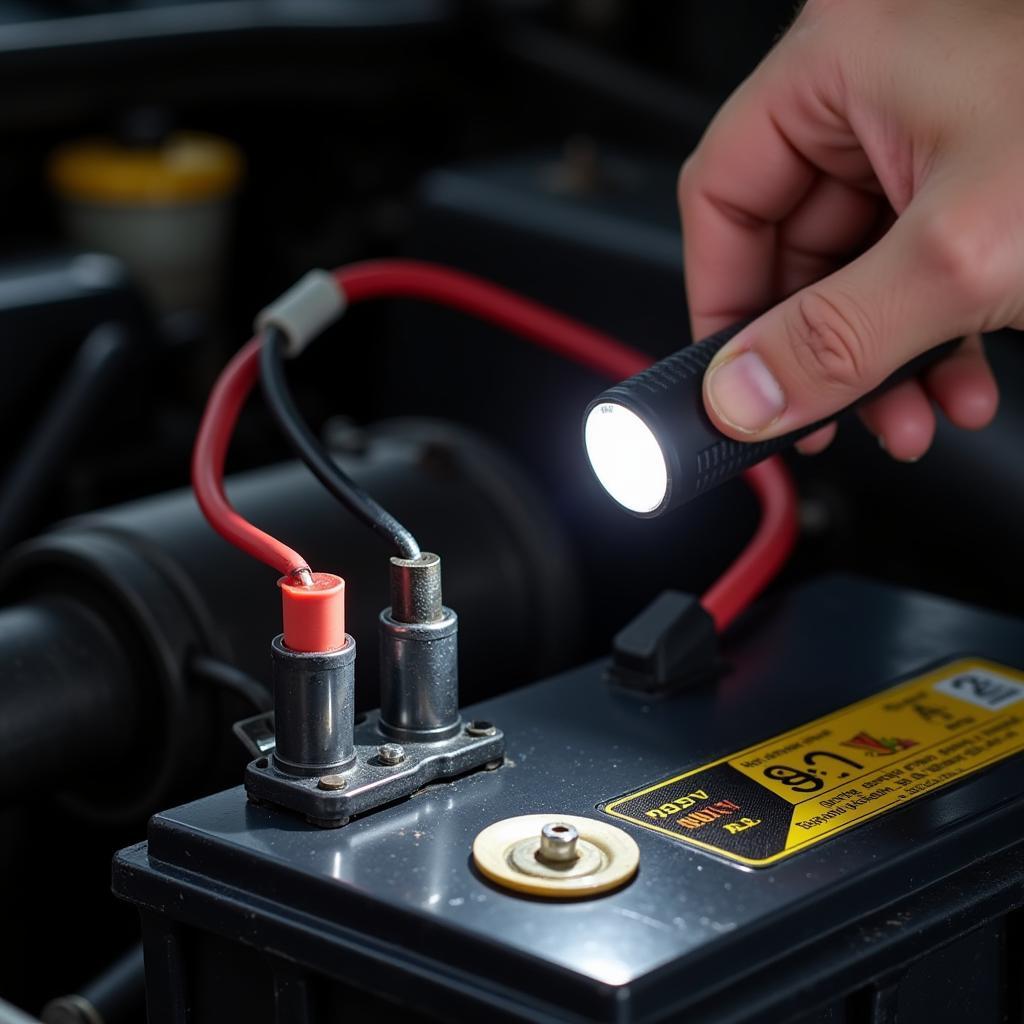Dealing with acid on top of your maintenance-free car battery can be a confusing situation. Is it normal? Is it dangerous? This article will delve into the reasons behind this phenomenon, discuss the safety precautions you should take, and guide you through the appropriate steps for handling it. We’ll explore the intricacies of maintenance-free batteries and what “maintenance-free” truly means.
Many car owners are under the impression that “maintenance-free” translates to “never needs attention.” However, this isn’t entirely true. While these batteries require significantly less maintenance than traditional lead-acid batteries, they aren’t completely immune to issues. One such issue is the appearance of acid residue on top of the battery. This residue, often a white, powdery substance, is usually caused by corrosion around the battery terminals. Learn more about lead acid car battery maintenance.
Why is There Acid on My Maintenance-Free Battery?
The “acid” you see isn’t pure sulfuric acid, but rather a byproduct of a chemical reaction. Hydrogen gas, released during the charging process, can mix with the electrolyte inside the battery and escape through vents. This mixture then reacts with the lead terminals, creating lead sulfate, which appears as a white, powdery deposit. Overcharging, high temperatures, and a faulty voltage regulator can exacerbate this process.
Is Acid on My Car Battery Dangerous?
Yes, the corrosive residue on your battery terminals can be dangerous. Direct contact can irritate your skin and eyes. Moreover, the corrosion can interfere with the electrical connection, leading to starting problems or even damage to your vehicle’s electrical system. Having the right car battery maintenance tools is crucial.
How to Clean Acid from a Maintenance-Free Car Battery
Cleaning the battery terminals is a relatively straightforward process. Always wear safety glasses and gloves. Disconnect the negative terminal first, followed by the positive terminal. Mix a solution of baking soda and water to create a paste. Apply the paste to the terminals and surrounding areas. The baking soda neutralizes the acid and helps loosen the corrosion. Use a wire brush to scrub away the residue. Rinse the area with clean water and dry thoroughly. Reconnect the positive terminal first, then the negative.
Can I Add Water to a Maintenance-Free Battery?
Some “maintenance-free” batteries are actually low-maintenance and might have caps that can be opened to check the electrolyte level. However, adding water to a truly sealed maintenance-free battery is difficult and often not recommended. Consult your owner’s manual or a professional mechanic for specific instructions regarding your battery type. For further information, you can learn more about add water to maintenance-free car batteries. Don’t forget, understanding your battery type is vital.
Preventing Acid Buildup on Your Car Battery
Regularly inspecting your battery terminals can help prevent excessive corrosion. Keep the terminals clean and dry. Ensure your charging system is functioning correctly. A faulty voltage regulator can lead to overcharging, which contributes to acid buildup. You might want to explore different battery options, such as the Chloride Exide dry maintenance free car batteries.
 Inspecting Car Battery Terminals for Corrosion
Inspecting Car Battery Terminals for Corrosion
What Does “Maintenance-Free” Really Mean?
“Maintenance-free” typically indicates that the battery is sealed and doesn’t require regular electrolyte level checks or top-ups. These batteries are designed with calcium-lead grids that reduce water loss, allowing them to operate for extended periods without intervention. However, they are not entirely immune to issues and can still benefit from periodic inspection and cleaning. More information on this topic can be found in this article on topping up maintenance free car battery.
Expert Insight: John Smith, ASE Certified Master Technician, emphasizes, “Even maintenance-free batteries require occasional attention. Regularly inspecting and cleaning the terminals can significantly extend their lifespan and prevent unexpected starting problems.”
Expert Tip: Maria Garcia, Lead Automotive Engineer, adds, “Extreme temperatures can affect battery performance. Be sure to have your battery checked before the onset of winter or summer.”
In conclusion, dealing with acid on top of a maintenance-free car battery requires understanding the cause, taking necessary safety precautions, and implementing the correct cleaning procedures. Regular maintenance and inspection are key to ensuring optimal battery performance and extending its lifespan. For personalized assistance or further questions, connect with the experts at AutoTipPro at +1 (641) 206-8880 or visit our office at 500 N St Mary’s St, San Antonio, TX 78205, United States.




Leave a Reply